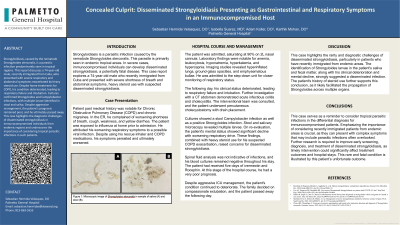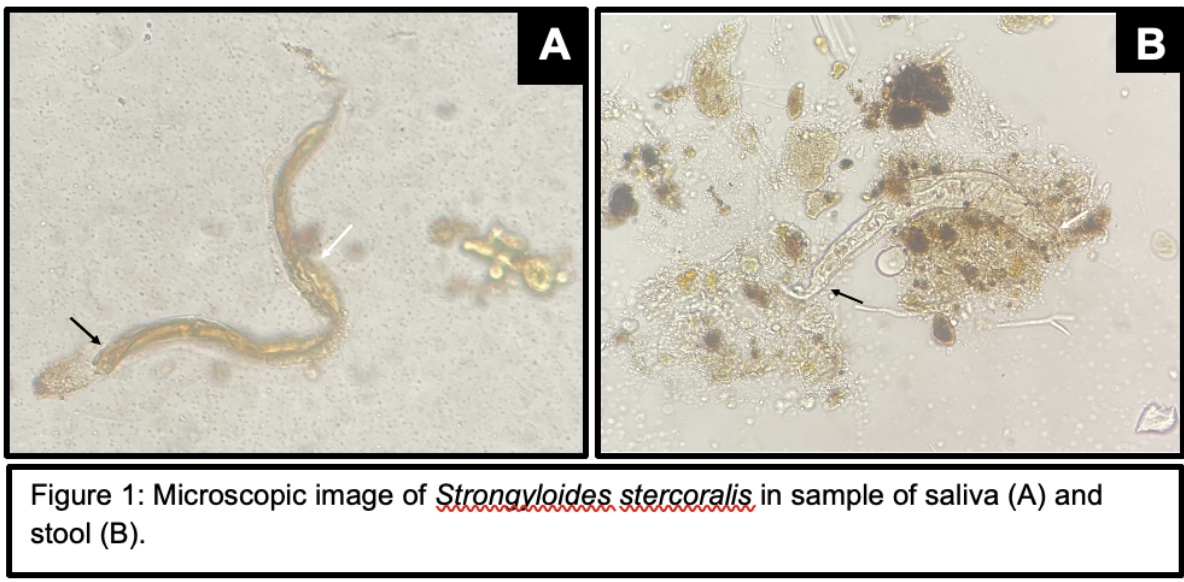Sunday Poster Session
Category: Colon
P0358 - Concealed Culprit: Disseminated Strongyloidiasis Presenting as Gastrointestinal and Respiratory Symptoms in an Immunocompromised Host
Sunday, October 27, 2024
3:30 PM - 7:00 PM ET
Location: Exhibit Hall E

Has Audio

Sebastian Hermida Velasquez, DO
Palmetto General Hospital
ZEPHYRHILLS, FL
Presenting Author(s)
Sebastian Hermida Velasquez, DO1, Isabella Suarez Alcala, MD1, Adam Koller, DO2, Jose Paz, DO2, Karthik Mohan, DO2
1Palmetto General Hospital, Hialeah, FL; 2Palmetto General Hospital, Miami, FL
Introduction: Strongyloidiasis is a parasitic infection caused by the nematode Strongyloides stercoralis, primarily seen in endemic tropical areas. In severe cases, immunocompromised individuals can develop disseminated strongyloidiasis, a potentially fatal disease with a mortality rate of 80%. We present the case of a patient with a history of chronic obstructive pulmonary disease (COPD) and a recent influenza infection, who recently migrated from Cuba and presented with gastrointestinal and respiratory symptoms resembling a viral syndrome.
Case Description/Methods: A 74-year-old male patient with a history of COPD and recent influenza presented to the emergency department with yellow diarrhea associated with severe shortness of breath, cough, generalized weakness that had been worsening for two weeks despite increased breathing treatments. He had migrated from Cuba one month prior to admission. Upon arrival, the patient had persistent diarrhea with hypoxemia and bilateral wheezing noted on physical examination. Laboratory workup revealed leukocytosis and hyponatremia. Due to abdominal tenderness, abdominal imaging was performed, revealing proximal colitis and acute cholecystitis, for which he underwent percutaneous cholecystostomy tube placement. A CT scan of the chest showed bilateral ground-glass opacities and emphysematous bullae. Despite receiving antibiotics, Tamiflu, steroids, and breathing treatments, he developed severe respiratory failure requiring intubation and mechanical ventilation. Stool studies were positive for Campylobacter and Strongyloides stercoralis (Fig. 1), for which he received azithromycin and ivermectin, respectively. Sputum analysis also revealed Strongyloides, raising concerns for disseminated infection in the context of systemic steroid use. He underwent further neurological workup due to persistent unresponsiveness with unclear etiology. Subsequently, given the poor prognosis, the family opted for palliative care, and he passed away the following day.
Discussion: In this case, the gastrointestinal manifestations, alongside respiratory distress, were key indicators of the underlying parasitic infection. Early recognition and treatment of strongyloidiasis in patients from endemic regions presenting with gastrointestinal symptoms are crucial to prevent fatal outcomes. This case underscores the need for vigilance and comprehensive diagnostic approaches in gastroenterology, especially when managing immunocompromised patients with atypical presentations.

Disclosures:
Sebastian Hermida Velasquez, DO1, Isabella Suarez Alcala, MD1, Adam Koller, DO2, Jose Paz, DO2, Karthik Mohan, DO2. P0358 - Concealed Culprit: Disseminated Strongyloidiasis Presenting as Gastrointestinal and Respiratory Symptoms in an Immunocompromised Host, ACG 2024 Annual Scientific Meeting Abstracts. Philadelphia, PA: American College of Gastroenterology.
1Palmetto General Hospital, Hialeah, FL; 2Palmetto General Hospital, Miami, FL
Introduction: Strongyloidiasis is a parasitic infection caused by the nematode Strongyloides stercoralis, primarily seen in endemic tropical areas. In severe cases, immunocompromised individuals can develop disseminated strongyloidiasis, a potentially fatal disease with a mortality rate of 80%. We present the case of a patient with a history of chronic obstructive pulmonary disease (COPD) and a recent influenza infection, who recently migrated from Cuba and presented with gastrointestinal and respiratory symptoms resembling a viral syndrome.
Case Description/Methods: A 74-year-old male patient with a history of COPD and recent influenza presented to the emergency department with yellow diarrhea associated with severe shortness of breath, cough, generalized weakness that had been worsening for two weeks despite increased breathing treatments. He had migrated from Cuba one month prior to admission. Upon arrival, the patient had persistent diarrhea with hypoxemia and bilateral wheezing noted on physical examination. Laboratory workup revealed leukocytosis and hyponatremia. Due to abdominal tenderness, abdominal imaging was performed, revealing proximal colitis and acute cholecystitis, for which he underwent percutaneous cholecystostomy tube placement. A CT scan of the chest showed bilateral ground-glass opacities and emphysematous bullae. Despite receiving antibiotics, Tamiflu, steroids, and breathing treatments, he developed severe respiratory failure requiring intubation and mechanical ventilation. Stool studies were positive for Campylobacter and Strongyloides stercoralis (Fig. 1), for which he received azithromycin and ivermectin, respectively. Sputum analysis also revealed Strongyloides, raising concerns for disseminated infection in the context of systemic steroid use. He underwent further neurological workup due to persistent unresponsiveness with unclear etiology. Subsequently, given the poor prognosis, the family opted for palliative care, and he passed away the following day.
Discussion: In this case, the gastrointestinal manifestations, alongside respiratory distress, were key indicators of the underlying parasitic infection. Early recognition and treatment of strongyloidiasis in patients from endemic regions presenting with gastrointestinal symptoms are crucial to prevent fatal outcomes. This case underscores the need for vigilance and comprehensive diagnostic approaches in gastroenterology, especially when managing immunocompromised patients with atypical presentations.

Figure: Figure 1: Microscopic image of Strongyloides stercoralis
Disclosures:
Sebastian Hermida Velasquez indicated no relevant financial relationships.
Isabella Suarez Alcala indicated no relevant financial relationships.
Adam Koller indicated no relevant financial relationships.
Jose Paz indicated no relevant financial relationships.
Karthik Mohan indicated no relevant financial relationships.
Sebastian Hermida Velasquez, DO1, Isabella Suarez Alcala, MD1, Adam Koller, DO2, Jose Paz, DO2, Karthik Mohan, DO2. P0358 - Concealed Culprit: Disseminated Strongyloidiasis Presenting as Gastrointestinal and Respiratory Symptoms in an Immunocompromised Host, ACG 2024 Annual Scientific Meeting Abstracts. Philadelphia, PA: American College of Gastroenterology.
